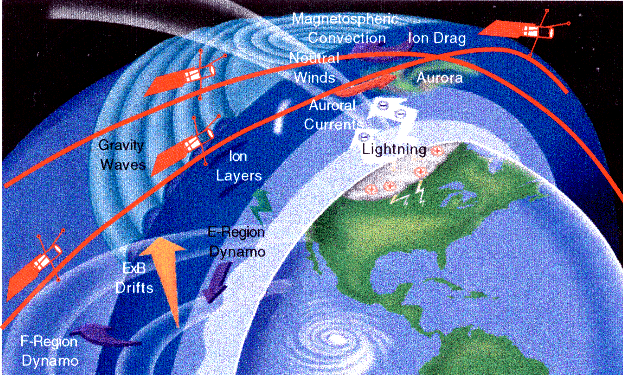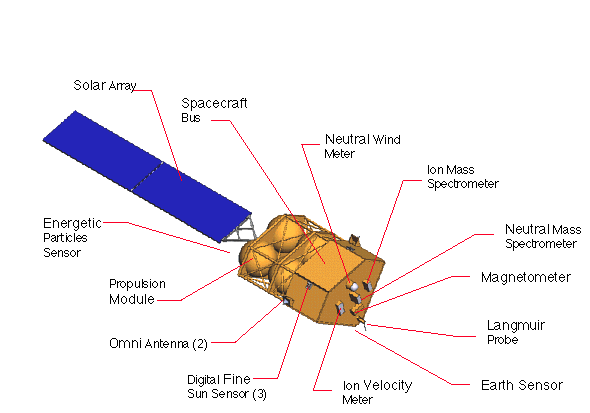GLOBAL ELECTRODYNAMICS MISSION


Meeting Notice
The Global Electrodynamics mission's inaugural Science & Technology Definition Team meeting is to be held August 24-26 at Goddard Space Flight Center in room 183, Building 21. Non-team members who wish to attend should contact Joe Grebowsky, code 695, NASA GSFC (phone:301-286-6853; email:u5jmg@lepvax.gsfc.nasa.gov).
Mission Overview
The transition region between the magnetosphere and dense atmosphere, i.e., the ionosphere, plays an essential role as the electrical conductivity channel that closes the magnetic field-aligned magnetosphere electric current loop and may play an important role in the global electric field circuit. It is the source region for magnetosphere plasma and a regime in which there is a tug-of-war going on between magnetosphere- and atmosphere- driven dynamics. It is a time varying and spatially complex medium.
A "single"-spacecraft mission to probe this inner boundary region of the geospace environment is not capable of unambiguously resolving the spatial and temporal complexities. Measurements of changes within an already dynamic system must be made. There are perturbations and coupling mechanisms with a broad range of spatial sizes and temporal scales which can only be studied and resolved in space and time by successive measurements in the same volume of space. Ground-based remote sensing techniques, such as Incoherent Scatter Radar, can examine some of these processes, but there are key parameters and spatial/temporal scales and locations in space that can only be measured in situ from satellite platforms. The Global Electrodynamics (GED) mission, consisting of a cluster of satellites, combined with ground-based observations will make systematic multipoint measurements to delineate and bring to closure our understanding of the important role the ionosphere plays in the Sun-Earth connection.
Major Science Thrusts
The theme of the mission is to establish the role of the ionosphere in the electrodynamic environment of near-Earth space. Within this context the major GED science objectives are:

Mission Scenarios
The mission definition is still evolving, but ideas for spacecraft orbital configurations have been studied and outlined in the report of the Multiprobe Science Definition Team. A focused investigation of the region between 200 km and 2000 km with multiple satellites in the same high inclination orbital trajectory has been recommended. Parking orbits 350 X 2000 km have been suggested with spacecraft excursions to altitudes below 200 km, maybe as low as 120 km, providing the opportunity for new discoveries. A study of the trade-offs between desired science accomplishments, spacecraft design, quantity of propellant needed and desired payload capability still needs to be made in order to tie down the best orbital configurations. One suggestion is a cluster of 4 spacecraft in high inclination orbits - three in the same orbit and one separated by one hour of local time. They would carry an amount of propellant that would allow many dips into the lower ionosphere. Remote viewing observations from a separate circular-orbiting spacecraft could provide a contextual view of the environment about the dipping satellites. An alternative view is that the remote sensing instruments should also be deployed on the dippers to provide an unprecedented high resolution sampling of the environment. However, technology and science constraints within the $120M cost ceiling (not including launch vehicle) still need to be folded into the final definition of the mission architecture.

A Conception of the Dippers
(from Orbital Sciences Corporation).
Electric field booms are not shown.
Measurements are needed of the concentrations of all relevant ionospheric and thermospheric constituents, their temperatures and velocities, the local electric and magnetic fields and the energetic particle distributions. Most measurements must be made from in situ measuring sensors but the important flow fields and complex auroral configurations would require remote-sensing detectors to provide a global context to the in situ observation.
Technology
In order to carry out its ambitious measuring goals GED is going to have to incorporate an advanced, miniaturized instrument packaging approach. If deep dipping is to be accomplished the technologies for efficient aerodynamics structures and advanced chemical propulsion need to be developed. Data compression techniques to support large volume, real time data flow from 4-5 satellites need to be employed.
Current Status
GED was cited as a future mission in NASA's Sun-Earth Connection Roadmap. It was further defined by the Geospace Multiprobes Science Definition Team. A preliminary spacecraft design was made by Orbital Sciences Corporation to bracket cost and weight constraints. A Community Science Workshop held at GSFC solicited an overview of what scientists thought the goals of GED should be. A Science and Technology Definition Team was selected in May 1998. This group will provide the final description of the GED mission.
GED & STP Program
GED has been slated to be one of NASA's Solar Terrestrial Probe (STP) missions, which is to be managed from Goddard Space Flight Center. TIMED is the first of the STP line, followed by STEREO, Magnetosphere Multiscale, GED and then Magnetosphere Constellation. Optimistically, an STP mission will be launched approximately every other year, with GED earmarked for 2007.